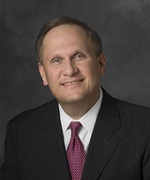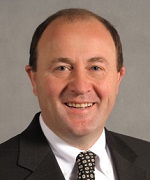 |
| Baxter International CEO Robert Parkinson |
Baxter International ($BAX) is the latest life sciences player to see better living through mitosis, unveiling a plan to separate its drug development arm from its sprawling med tech business in hopes of helping each grow faster.
Under the terms of Baxter's breakup, its $6 billion-a-year pharma unit will strike out on its own by mid-2015, focusing on drugs for bleeding disorders and immune deficiencies under the leadership of current bioscience chief Ludwig Hantson. Baxter's $9 billion medical device and diagnostics segment will retain the old company name and look to expand its sizable share of the dialysis market, and CEO Robert Parkinson will remain at the helm.
Baxter's drug business is largely propped up by its hemophilia franchise, led by the treatments Advate and Feiba, and the company is counting on the Phase III factor VIII treatment BAX 855 to keep things rolling, planning to file for FDA approval this year. Behind 855, Baxter is working through Phase III for a factor VIIa treatment and Phase I for a hemophilia gene therapy, drugs the company believes present a roughly $2 billion global opportunity.
 |
| Baxter BioScience President Ludwig Hantson, who will serve as CEO of its spinout |
But the long-range plan for the Illinois company's as-yet-unnamed spinout involves spreading out beyond hemophilia and reaching into hematology and oncology, and the company has worked to flesh out its pipeline through partnerships with Onconova ($ONTX) and Cell Therapeutics ($CTIC) over the past 18 months. And Baxter has its eye on biosimilars as well, teaming up with Coherus BioSciences to develop a knockoff of Amgen ($AMGN) and Pfizer's ($PFE) blockbuster Enbrel and planning to file for FDA approval in 2016.
"We are transforming our pipeline into a robust portfolio of products," Hantson said on a conference call with investors. "... I'm confident that our investments are beginning to pay dividends, as we plan to launch more than 10 products over the next four or 5 years."
Meanwhile, citing unnamed sources, Reuters reported on Wednesday that Baxter is looking into selling off its $300 million-a-year vaccines business. Baxter acknowledged "the potential divestiture" without getting into specifics, but, perhaps tellingly, the company relegated the unit's 2013 revenue to a footnote in its presentation accompanying the announcement.
Over on the med tech side, Baxter is looking to tighten its hold on the dialysis market, bolstered by its roughly $4 billion acquisition of ex-rival Gambro last year. The company is still trudging through the integration process, but Parkinson said Baxter is well-positioned to become a leader in infusion systems, surgical products and nutritionals.
Baxter's move follows a similar splits by Abbott Laboratories ($ABT), which spun out its proprietary drug unit into AbbVie ($ABBV) last year, and Pfizer, which transformed its animal health segment into the standalone Zoetis ($ZTS). Like most diversified healthcare outfits, Baxter had long faced questions about whether it would follow suit, and Parkinson had repeatedly affirmed his faith in the value of keeping the band together, most recently dispelling the idea at January's J.P. Morgan Healthcare Conference. So what changed?
"The question is, when do the merits of a spinoff begin to generate more value?" Parkinson said on the call. "It's our view that, today, we're at that point, and, going forward, we think that value will only increase over time."
And, as Parkinson pointed out, this isn't Baxter's first go at the spinout process. The roughly 80-year-old company birthed Caremark in 1992, Allegiance in 1996 and Edwards Lifesciences ($EW) in 2000, and each transaction created shareholder value, the CEO said.
- read the announcement
- here's FierceMedicalDevices' take